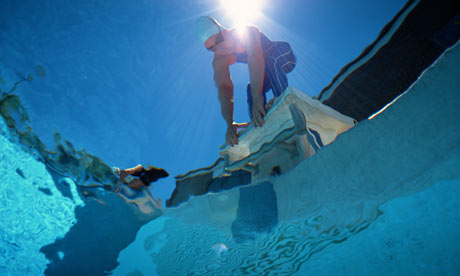Swimming
Getting started
Swimming is an invigorating workout that provides a welcome break from exercising on dry land. But are you making the most of your pool time?

Swimmer about to dive into the water. Photograph: Alamy
----------------------------------------------------------------------------------------------
Buy Swimming Stuff >>>
* Accessories
* Rash Guard Shirts
* Sunglasses
* Swim Caps
* Swim Fins & Socks
* Swimwear
* Training Aids
* Water Shoes
----------------------------------------------------------------------------------------------
Swimming is a form of exercise that works all the body's major muscles and the cardiovascular system better than most others - and Britons love it. Statistics from the Department of Culture, Media and Sport suggest that 12 million Britons are regular swimmers with 22% of adults and 50% of children frequently taking a dip in their local pool. Yet, despite its popularity, many who enjoy the exercise aren't swimming efficiently.
Physiotherapists generally rate swimming as the best exercise for those with vulnerable joints and injury problems. "Water acts as a giant cushion and is much kinder to the joints and tendons than terra firma because it supports your body weight," says Sammy Margo, a physiotherapist who has worked with many elite swimmers. "But bad technique can aggravate existing problems."
Poor habits can make swimming harder than it needs to be. "If your technique is bad, then each swim will be tough and you won't swim as far as you could," says Olympic medalist David Davies. "The best thing you can do before starting to take swimming more seriously is to perfect the way you do it."
Benefits of even small tweaks to technique can be huge. A study published in the European Journal of Applied Physiology showed that improving the technique of a group of swimmers resulted in them expending less energy per length and also completing a set distance more speedily.
Where to learn
If you're keen to kick bad habits and gain confidence in the pool, there are plenty of places to start. The Amateur Swimming Association (britishswimming.org) runs nationwide schemes to help people improve their technique. For instance, Everyday Swim (run in conjunction with Sport England), aims to increase participation in the sport by 2% a year. Likewise, the ASA Kellogg's Swim Active programme offers free instruction at selected pools to families with young children. Alternatively, private tuition at schools like Karen Pickering SWIM (karenpickering.co.uk), held at pools around the country, is worth the small investment.
The importance of warming up
• "Before you get in the water, it's important to make sure your body is warmed up," says Olympic swimming coach Bill Furniss. "Do some jogging on the spot or hop on an exercise bike before attempting to stretch."
• To stretch your shoulders, stand with your back straight and feet hip-width apart, knees slightly bent. Lifting from your rib cage, raise both arms as far above your head as you can.
• Just before you get in, jump in the shower to make sure you are really warm. Do a few more stretches poolside, but don't allow yourself to get cold.
• "The first few lengths of any swimming session should be a continuation of the warm-up," Bill adds. "Never get in and go hell for leather. Gradually increase your pace, and use kickboards and pull-buoys to get your arms and legs ready for the more intense effort to come."



0 comments
Post a Comment